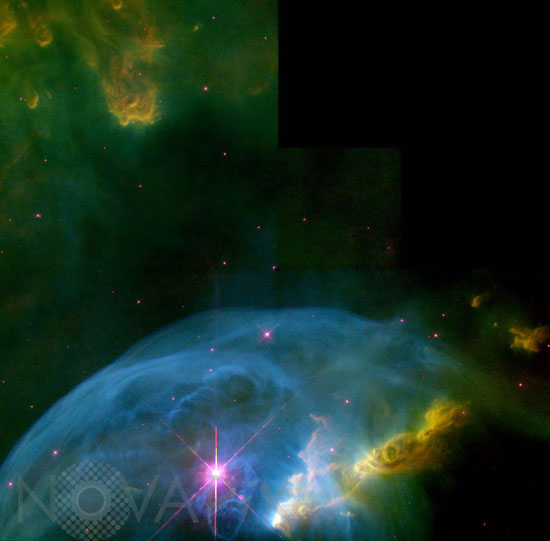Photo Agency - Astronomy - Space - Nature

The Bubble nebula (NGC 7635) in Cassiopeia
author: Nasa/Novapix
reference: a-neb76-35011
Image Size 300 DPI: 12 * 12 cm
Astronomers, using the Wide Field Planetary Camera 2 on board NASA's Hubble Space Telescope in October and November 1997 and April 1999, imaged the Bubble Nebula (NGC 7635). For the first time, they are able to understand the geometry and dynamics of this very complicated system. The remarkably spherical "Bubble" marks the boundary between an intense wind of particles from the star and the more quiescent interior of the nebula. The central star of the nebula is 40 times more massive than the Sun and is responsible for a stellar wind moving at 2,000 kilometers per second (4 million miles per hour or 7 million kilometers per hour) which propels particles off the surface of the star. The bubble surface actually marks the leading edge of this wind's gust front, which is slowing as it plows into the denser surrounding material. The surface of the bubble is not uniform because as the shell expands outward it encounters regions of the cold gas, which are of different density and therefore arrest the expansion by differing amounts, resulting in the rippled appearance. It is this gradient of background material that the wind is encountering that places the central star off center in the bubble. There is more material to the northeast of the nebula than to the southwest, so that the wind progresses less in that direction, offsetting the central star from the geometric center of the bubble. At a distance of 7,100 light-years from Earth, the Bubble Nebula is located in the constellation Cassiopeia and has a diameter of 6 light-years. Located at the top of the picture are dense clumps or fingers of molecular gas which have not yet encountered the expanding shell. These structures are similar in form to the columns in the Eagle Nebula, except that they are not being eroded as energetically as they are in that nebula. As in the Eagle, the clumps are seen to emit light because they are being illuminated by the strong ultraviolet radiation from the central star, which travels much faster than the shell and has reached the outer knots long before the expanding rim will.
Contact : Stéphane Aubin +33-(0)9-51-26-53-76
© Novapix - All rights reserved


